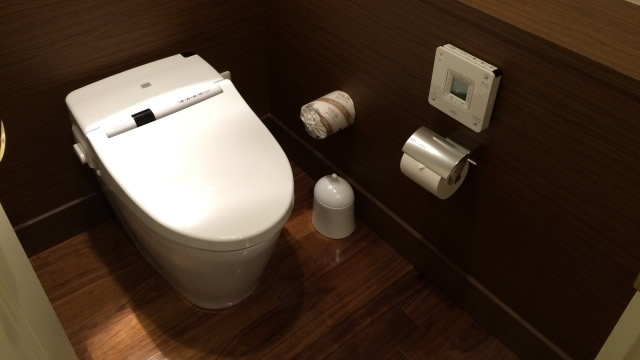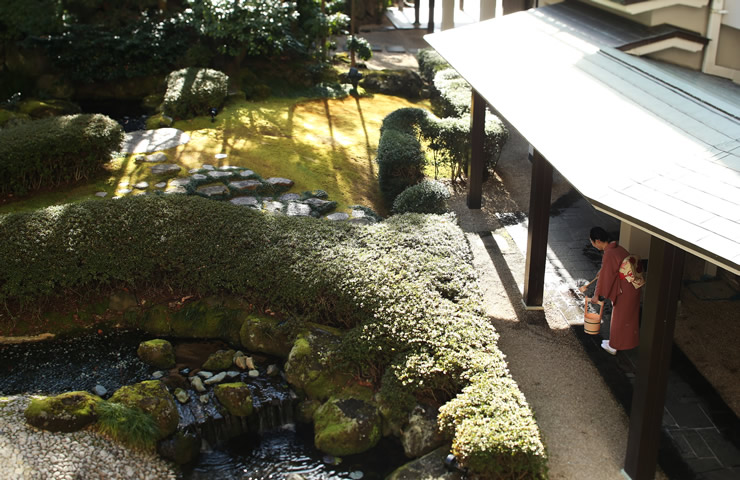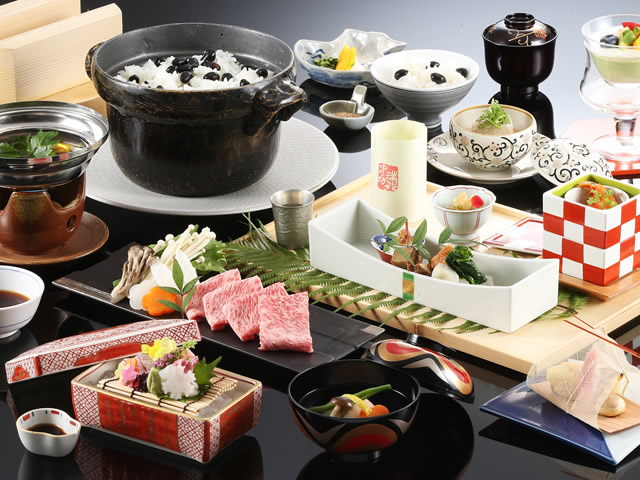Ryokan Manual
Understanding the Ryokan Culture
You will experience authentic traditional Japanese culture and customs and indulge in traditionalold-fashion Japanese hospitality and service at its legendary best. By understanding some of the customs and practices of a ryokan, you will be assured of a memorable experience and be able to enjoy the most of your stay.
What’s a Ryokan
A ryokan is a traditional Japanese-style inn and has been a central part of Japanese culture for centuries. Here guests can get a taste of Japanese traditional home life.
Checking In and Out
Check-in time is from 13:00pm. Try to check-in before 5:30pm as the ryokan may not be able to serve you dinner after 7:00pm. The reason is the ryokans serve fresh, seasonal food and as a result, dinner is served as soon as it is cooked and no later. If the dinner is already prepared but sits there for several hours there is a good chance it will be spoiled. If you check-in early, you may leave your luggage at the ryokan and go sightseeing before returning for dinner.
The reception at a ryokan closes early. Be sure to confirm both the check-in and check-out times.
Guest Rooms
A typical ryokan room is patterned on rooms in classical Japanese houses and contains : shoji (sliding paper doors) which separates the agari-kamachi from the room.
- ・Tatami mat flooring (reed floor matting)
- ・Low wooden tables
- ・Zabuton (sitting cushions)
- ・Futon (sleeping quilts)
- ・A tokonoma (an ornamental alcove built into the wall used for placing flower vases and hanging scrolls)
- ・Oshiire (a closet for futon sleeping quilts)
- ・A glass enclosed sitting area separated from the room by a shoji
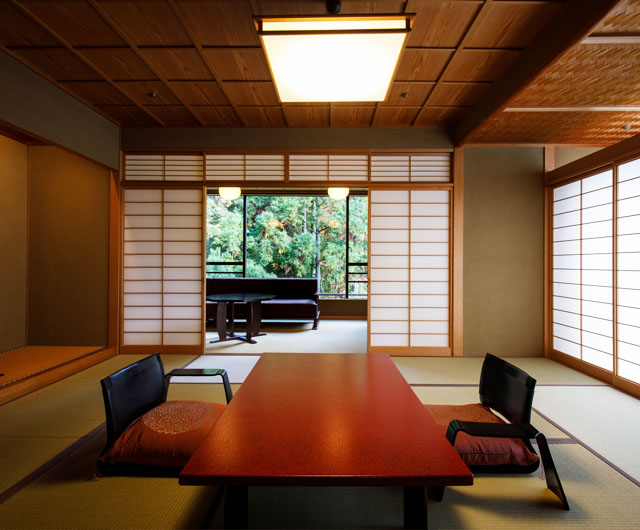
Checking into your Room
- ・a glass enclosed sitting area separated from the room by a shoji.
- ・She will be responsible for assisting you to make your stay comfortable.
- ・Direct any questions or requests concerning the ryokan to her.
- ・She will show you where to place your luggage.
- ・Interpretation service is available on request if communication becomes a challenge.
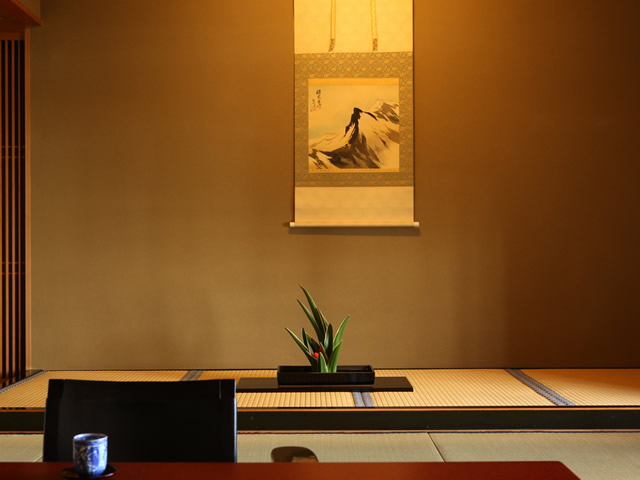
In the Room
- ・Remove your slippers before entering the tatami-floored room.
- ・You will be provided with a yukata (kimono-like robe) which you can wear in your room, around the ryokan, or when you take a short walk near the ryokan or in the hot spring area. If it is cold, a tanzen (outer robe) will be provided.
- ・There is usually an ornamental recess/alcove (tokonoma) in the room which is raised one step above the tatami floor.
- ・This is an auspicious place adorned by a hanging scroll, a vase, or flower arrangement. It is taboo to place your luggage, handbag or anything there.
- ・If it rains, please be sure to close the outside glass window.
How to wear the Yukata
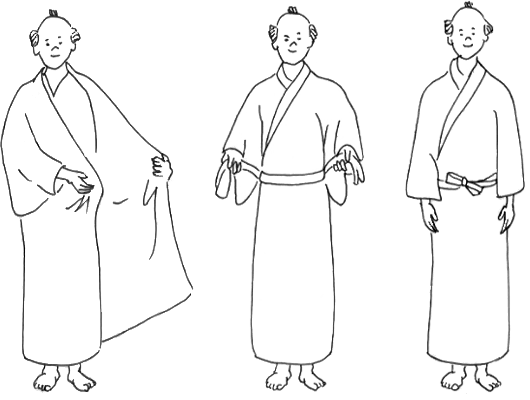
Bedtime
- ・Your maid will prepare your futon (sleeping quilts) every night and put it away in the morning.
- ・First a mattress is laid on the floor, and it is usually a few inches thick and just soft enough.
- ・If it is not soft enough, ask the maid to double them up — each room usually has enough bedding for six or eight people.
- ・Then there is a quilt, wrapped in a sheet, then you, then another quilt, wrapped in a sheet or a duvet, all together comprising a “futon”.
- ・Apart from the pillows, which are both small and hard, it is a very comfortable and relaxing bed.
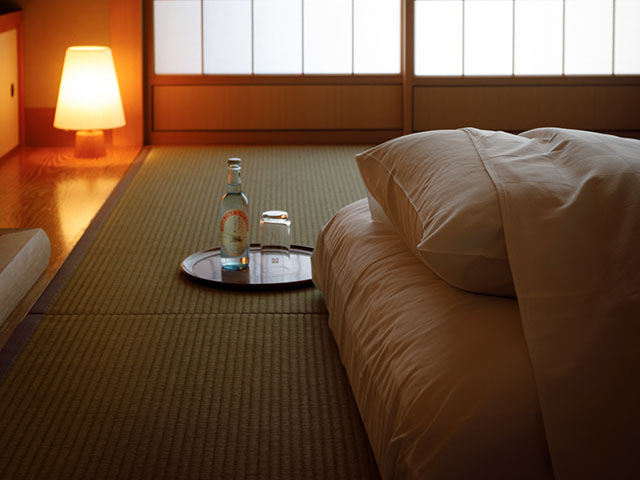
Meals
- ・Meals are usually Japanese style full-course menu although Western-style meals (Breakfast only) can be served upon request. However, it is best to send in requests early, preferably when confirming your booking. In keeping with the spirit of Japanese hospitality, courses are brought in fresh and at their best, just as they would be at home.
- ・Dinner is served between 5:30 pm and 7:30 pm and breakfast between 7:30 am and 9:30am, served either in your room or in the private dining room.
*Shunsai Inano (Japanese cuisine) [Service hours] 11:30 – 15:00 (Lunch), 17:00 – 21:00 (Dinner) - ・For dinner, guests are usually served traditionally prescribed kaiseki, or tea-ceremony, style. This is usually an 8 to 13-course dinner consisting of a wide variety of small dishes with local specialties of Sashimi (raw fish and shellfish), Nabemono (meat, vegetables, fish boiled in a pot), tempura (deep fried fish and vegetables), grilled fish, boiled vegetables and meats, vegetables hors d’oeuvres, soy-bean paste soup, and rice.
- ・You will usually be provided with chopsticks although you may request for Western tableware.
- ・Beverages (except Japanese Tea) and additional courses are available at extra charge.
- ・We serve Western-style breakfast or Japanese-style breakfast at your choice.
*Japanese-style : steamed rice, miso (bean paste) soup, grilled fish, fried eggs, nori (dried seaweed) and so on.
*Western-style : Bread, bacon & eggs, salad, soup, fruits, juice, coffee and so on.
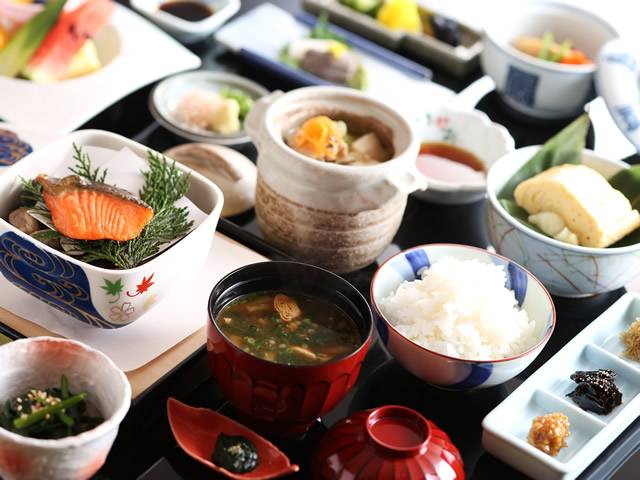
Dinner (an example)
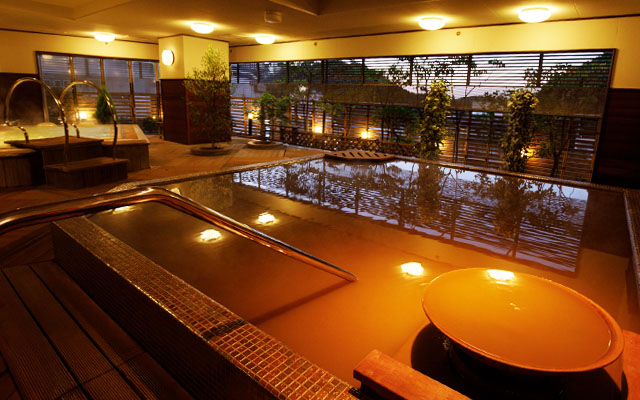
Breakfast (an example)
The Bath
The Japanese consider a long hot bath to wash away the day’s weariness a major ryokan attraction and you should also find time to indulge in it. Your room may be provided with a private bath or you may choose to use the communal bath. Men and women bath separately.

-
Place your clothing in the locker and clean yourself.
Use a washbowl to scoop hot water out of the tub to rinse yourself with.
-

Step into the bath tub. Do not use soaps in the bath tub. The tub of water is for everyone. The water temperature should be between 38℃ and 42℃ and the water should be deep enough that an adult can sit submerged up to the neck.

-
Get out of the tub, sit down on the low stool provided along the wall wash yourself thoroughly. You can wash your hair now, too.

-
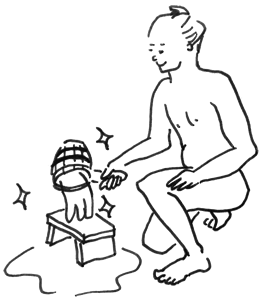
Use the shower or water to clean any remaining soap or shampoo from the floor.
How to Shower Toilet
- 1. Relieve myself
- 2. Wipe with toilet paper
- 3. Press the appropriate button on the shower toilet
- 4. Press the stop button after 4-5 seconds
- 5. Wipe away moisture with toilet paper
- 6. Flush
